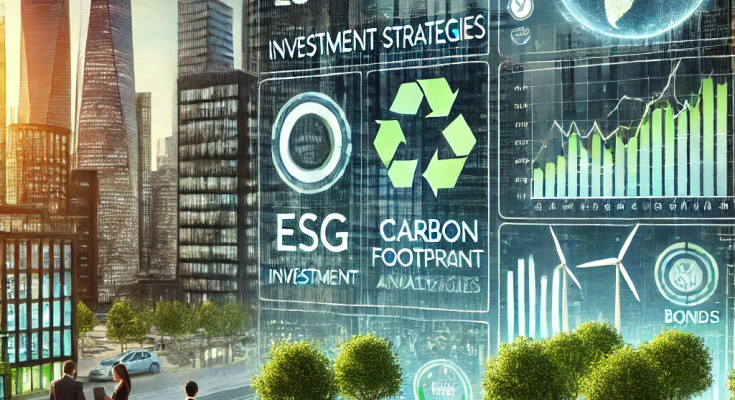Introduction
As climate change concerns grow, sustainable finance and decarbonization have become key priorities for investors, businesses, and financial institutions.
Governments and corporations are increasingly committing to net-zero emissions, prompting investors to shift capital toward low-carbon and environmentally responsible assets. Meanwhile, regulatory bodies are introducing stricter climate-related financial disclosures, pushing companies to integrate Environmental, Social, and Governance (ESG) principles into their strategies.
This article explores how sustainable finance and decarbonization are reshaping investment strategies, the key trends driving this shift, and what businesses and investors can expect in the future.
What is Sustainable Finance?
Sustainable finance refers to investment and lending strategies that prioritize environmental and social factors alongside financial returns.
💡 Key components of sustainable finance include:
• Green finance – Investments that support renewable energy, clean technology, and low-carbon infrastructure.
• ESG investing – Incorporating environmental, social, and governance factors into investment decisions.
• Climate risk assessment – Evaluating how climate-related risks impact financial stability.
• Decarbonization funding – Financing businesses that are reducing their carbon footprint.
How Decarbonization is Reshaping Investment Strategies
1. The Rise of Green Bonds & Sustainable Debt Markets
Green bonds and sustainability-linked loans are experiencing record growth as corporations and governments seek funding for climate-friendly initiatives.
• Green bonds fund projects like solar farms, wind energy, and sustainable infrastructure.
• Sustainability-linked loans (SLLs) tie interest rates to a company’s environmental performance.
• The global green bond market surpassed $1 trillion, with 2025 expected to be a record year.
💡 Example: Apple has issued billions in green bonds to finance renewable energy projects and supply chain decarbonization.
2. ESG Investing: From Niche to Mainstream
Institutional investors are increasingly prioritizing ESG factors in their portfolios.
🔹 What’s driving ESG investing?
• Rising climate regulations and mandatory carbon disclosures.
• Increased demand for ethical and impact-driven investments.
• Growing evidence that sustainable investments outperform traditional assets in the long run.
💡 Example: BlackRock, the world’s largest asset manager, has shifted billions into ESG-focused funds, citing strong long-term returns.
3. Net-Zero Commitments & Corporate Decarbonization
Major corporations are committing to net-zero carbon emissions, reshaping investment decisions.
🔹 How companies are decarbonizing:
✅ Switching to renewable energy sources.
✅ Investing in carbon capture and storage (CCS) technology.
✅ Reducing supply chain emissions through sustainable sourcing.
💡 Example: Amazon’s Climate Pledge Fund invests in carbon-neutral technologies to achieve net-zero operations by 2040.
4. Regulatory Pressures & Climate Disclosure Requirements
Governments and financial regulators are enforcing stricter sustainability reporting rules, requiring companies to:
• Disclose carbon emissions and climate risks in financial reports.
• Align with global climate frameworks, such as the Task Force on Climate-related Financial Disclosures (TCFD).
• Adopt science-based targets for emissions reductions.
💡 Example: The European Union’s Corporate Sustainability Reporting Directive (CSRD) now mandates detailed ESG disclosures for large companies.
Challenges & Risks in Sustainable Finance
Despite its momentum, sustainable finance faces key challenges:
⚠️ Greenwashing Risks – Some companies exaggerate their environmental impact without real sustainability efforts.
🔹 Solution: Investors are demanding third-party ESG verification and stricter regulations.
⚠️ Inconsistent ESG Data & Ratings – Lack of standardized metrics makes ESG comparisons difficult.
🔹 Solution: The adoption of global ESG reporting standards is improving transparency.
⚠️ Transition Risks – Companies failing to decarbonize may face regulatory fines, investor divestment, or stranded assets.
🔹 Solution: Businesses must adapt early to remain competitive in a low-carbon economy.
The Future of Sustainable Finance & Decarbonization
🔮 AI & Big Data in ESG Analysis – Advanced AI will help investors analyze real-time ESG data for smarter investment decisions.
🔮 Carbon Markets & Offsets – Companies will buy and trade carbon credits to meet emissions targets.
🔮 More Climate-Focused Regulations – Governments will enforce stronger decarbonization policies, making sustainability a business imperative.
🔮 Investor-Led Climate Action – Shareholders will push companies to adopt aggressive net-zero strategies, influencing boardroom decisions.
Sustainable finance and decarbonization are no longer optional—they are defining the future of investment strategies.
Key Takeaways:
✔️ Green bonds, ESG investing, and net-zero commitments are shaping financial markets.
✔️ Companies must embrace decarbonization to attract capital and remain competitive.
✔️ Governments are enforcing stricter climate disclosure regulations.
✔️ The future of finance will be driven by climate-conscious investors, AI-driven ESG analysis, and regulatory mandates.
As sustainable finance continues to grow, businesses and investors who lead the way in decarbonization will gain a competitive edge in the evolving financial landscape.


